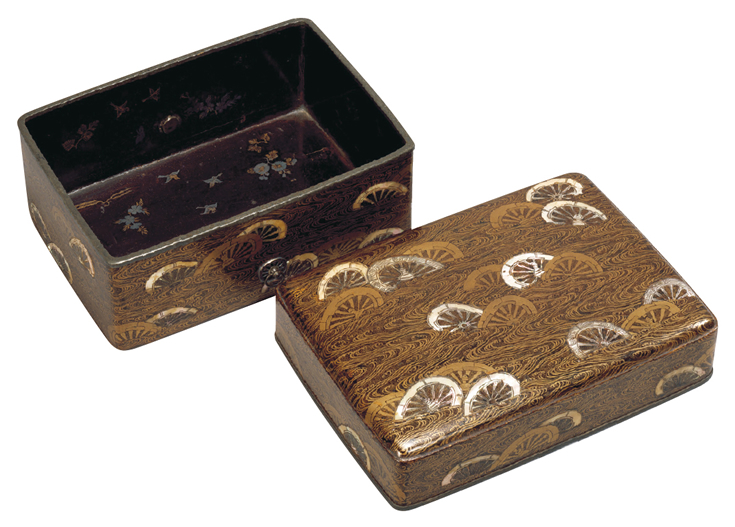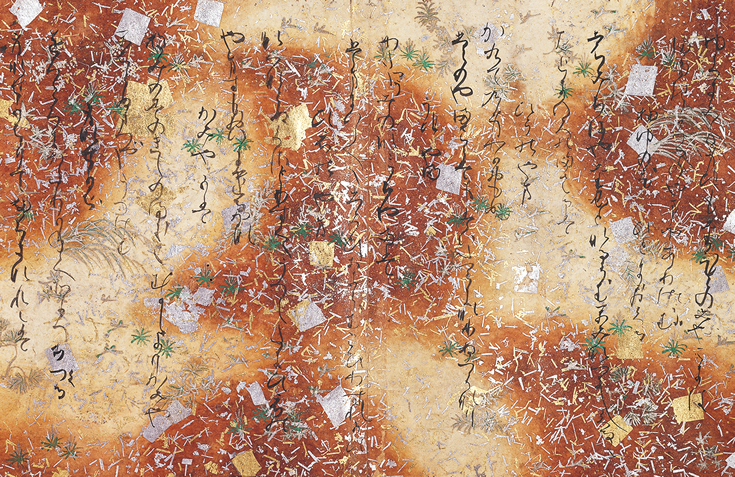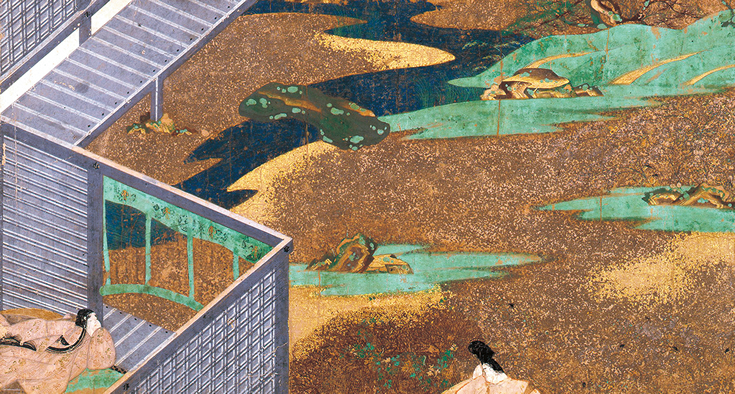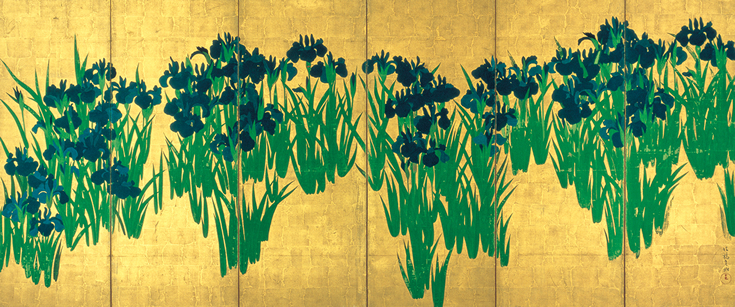niponica is a web magazine that introduces modern Japan to people all over the world.
2014 No.14

To read the e-book you need to have JavaScript enabled in your browser and a free Flash Player plug-in from Adobe Systems Inc. installed.
Splendor and Sparkle in Japanese Culture

Japan’s Dazzling Artistic Traditions
Writings, pictures, crafts, architecture... Colorful decorative art shines at the heart of Japanese culture.
From a conversation with Hidaka Kaori

Ink stone box with cover, depicting wheels in flowing water. 12th century. The makie artist sprinkled gold powder on wet lacquer, to make a background for the illustration, which is made with gold along with sei-kin (a gold-silver alloy) and mother-of-pearl. Box name: Kata-waguruma makie raden te-bako. Property of the Tokyo National Museum. (Photo courtesy of the Kyoto National Museum)
For many years, one aesthetic in Japanese art found beauty in avoiding decoration, embracing simplicity, and using colorless monotones. Meanwhile, another tradition blended gorgeous materials such as gold and silver with vibrant color, fostering brilliance and ornateness.
Resplendent art for Buddhist scriptures and waka poetry
Using gold to depict the supernatural religious sphere in a decorative way is common throughout the world, and Buddhism is certainly no exception. In fact, one sutra says that a light shone from the Buddha. In Japan, beginning in the Heian period (794-1192), some statues of Buddha and temple interiors were decorated with gold. In China and other parts of East Asia, there were Buddhist texts transcribed in gold or silver calligraphy, and in Japan this practice was taken further, with gold and silver decorating many objects.
At the end of the 12th century, the ruling class gave religious institutions sutra prayer texts and works of art done by nobles, such as waka poetry collections and picture scrolls, and these were often brilliantly decorated. We can feel the nobles’ artistic sensibilities even through their secular scrolls, which were sometimes decorated, like the scriptures, with gold and silver.
Haku-chirashi (“scattered gold or silver”) was one of the most common decorative techniques in those days. Gold and silver leaf was cut into different sizes, or pulverized into a powder, or shredded into random shapes, and then they were mixed on paper to create a mystical world of illusion. This technique was soon applied to pictures as well. Artists sought elegant beauty by harmonizing the opulent brilliance of gold with the strong whitish hue of silver and the refinement of color.

Part of the Mitsune Collection of waka poetry, decorated with haku-chirashi (“scattered gold or silver”). This work, called Hongan-ji bon sanjuroku-nin kashu, probably dates back to 1112. Property of Hongan-ji Temple.
Playful touches, taking liberties with reality
Chinese and Western pictures generally aimed for realism, wishing to represent things as they actually were. At one time Japanese art was greatly influenced by China, but in the end it turned in a quite different direction. Rather than trying to express lofty ideals through a faithful portrayal of reality, artists in Japan displayed a playful spirit in design elements and eye-pleasing effects.
For example, the ink drawings of Chinese landscape artists emphasized the ruggedness of boulders and the craggy steepness of cliffs, whereas Japanese pictures tended to avoid shadings and gradations to portray the unevenness of the land, and instead treated topography as a flat surface to be decorated with gorgeous materials, including gold and silver. Some of the many large folding screens produced in Japan beginning in the 16th century were covered with copious amounts of gold leaf. This caused them to lose depth and some stereoscopic effect, but on the other hand they achieved a unique form of expression through remarkable layouts of flowers, trees, animals and the like.
This technique, where perspective is intentionally ignored, led to many notable pieces of decorative art. They indicate how Japanese artistic sensibilities were quite different from the approach taken by Chinese paintings.

Some of the stories the aristocracy read were elaborately illustrated. This scene, from a picture scroll entitled Ise monogatari emaki shodan, dates from the late 13th century or early 14th century. Property of the Kuboso Memorial Museum of Arts, Izumi City.
A penchant for glitter throughout the history of Japanese decorative art
Makie decorative techniques combine lacquer and a sprinkled powder, usually gold or silver. This traditional Japanese lacquer craft began in the 8th century and evolved through various stages of development. Raden zaiku (mother-of-pearl inlay), using shiny pieces of shell, is also seen in other parts of the world, but interestingly, in Japan the inlay was combined with makie to achieve an even more exotic effect.
The gold leaf on Japanese pictures of the time was so thin that surprisingly little gold was used. On the other hand, the gold powder particles for makie are much thicker than gold leaf, so far more gold had to be used in makie for a given surface. That explains why makie gold gives the impression of solid mass.
Beginning in the 10th century, the culture of the nobility favored makie and mother-of-pearl inlay to grace the lives of the wealthy, as seen in their diverse furnishings, architectural embellishments and more. Later, when the military class held power in the Kamakura period (1192-1333), dramatic makie backgrounds became even more opulent with gold leaf.
Wabi and sabi are cultural values that sprang from the tea ceremony in the 16th century. They idealized simplicity and tranquility, in contrast to the opulence of the aristocracy. Although wabi and sabi developed into one highly influential branch of aesthetics, the Japanese certainly did not abandon their penchant for glitter. For instance, the ornamental decorations promoted by the Rinpa school of Ogata Korin (1658-1716) became increasingly prevalent in the Edo period (1603-1867).
Japan's aesthetic values today favor bold, innovative design and feel-good effects, and against this backdrop the culture of kawaii (“cute”) rules in the pop world. Japan’s glittering decorative traditions live on today.

“Bold yet simple” describes these flowers on the gold background of a truly remarkable folding screen. By Ogata Korin, a master artist of the Rinpa school, this screen is the right half of a pair. Screen name: Kakitsubata-zu byobu. 18th century. Property of the Nezu Museum.
Hidaka Kaori
Professor at the National Museum of Japanese History (Museum Science Division). Specializes in the history of lacquer ware art, especially makie, and in Japanese decorative art. Works include Nihon Bijutsu no Kotoba Annai (“A Guide to Japanese Art Terminology”).




